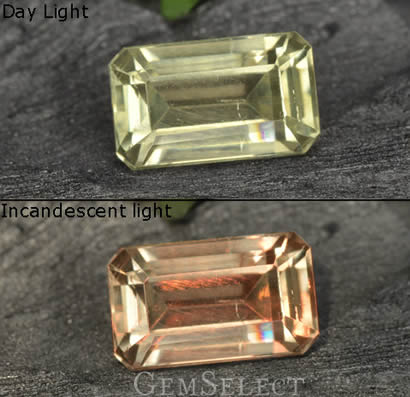Zultanite, Csarite or Diaspore?
Over the centuries that man has been scouring the earth for valuable minerals, one would think that all the different types of gemstones had already been discovered. However, new ones seem to be found on a fairly regular basis and some of these have become very important with regard to the international gemstone and jewelry market.

Color Change Diaspore Gemstone
Tanzanite was discovered as recently as the 1960s and tsavorite garnet in the 1970s, both in East Africa. Chrome diopside was first found in Russia in the 1980s, and Paraiba tourmaline from Brazil first appeared on the market in the early 1990s. More recently there has been a lot of publicity surrounding andesine labradorite, though it turned out to be not 'andesine', but color-enhanced labradorite.
The latest discovery in the gemstone world is the delicately colored Zultanite gemstone, known for its attractive color-change properties. It is also marketed as Csarite and Color Change Diaspore, all referring to the same gem-quality variety of diaspore that showcases a rare optical phenomenon. Mined from a single deposit in the mountains of Central Turkey, the names Zultanite and Csarite are more marketing terms than official gemstone trade names. These names were introduced by the mining rights holder, Murat Akgun. The name 'Zultanite' is believed to pay homage to the sultans who once ruled the Ottoman Empire. Browse through our large selection of color change diaspore for sale.
Although the names Zultanite and Csarite are relatively recent, this mineral has been recognized since 1801, when it was first discovered in the Ural Mountains of Russia. Gemologically, it is known as 'diaspore' and is a form of hydrated aluminum oxide that gets its color from manganese. While it was first cut as a gemstone in the 1980s, commercial mining only began in more recent years.
Diaspore has reasonably good gemstone characteristics. It has a hardness of 6.5 to 7 on the Mohs scale, comparable to peridot and tanzanite. It has a refractive index of 1.702 to 1.750, which lies between that of tanzanite and spinel. Diaspore has perfect cleavage in one direction, making it a challenge to cut.
Gems that change color under different lighting are rare and color-change diaspore is attracting buyers who are drawn to this unique quality. Under natural or fluorescent light, diapsore has a kiwi green color, with flashes of yellow. Under incandescent lighting, this shifts to a champagne color, and when exposed to subdued lighting, such as candlelight, diaspore has a pinkish color. The degree of color change can vary from stone to stone, but most exhibit subtle change. Typically, the larger the stone, the more pronounced the color change effect will be. Large gemstones with very strong color-change often sell for excess of hundred dollars per carat as they are extremely rare.
Diaspore deposits have now been found in a number of locations around the world, including Arizona and Pennsylvania in the USA, New Zealand, Brazil, Argentina, Russia, the United Kingdom and China. However, to date, the only gem-quality, facetable material has been mined in Turkey.
|
